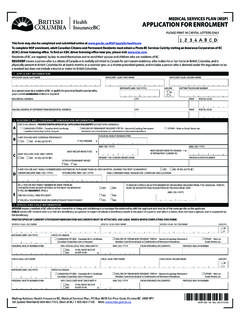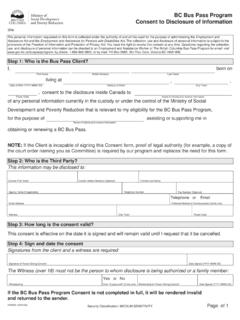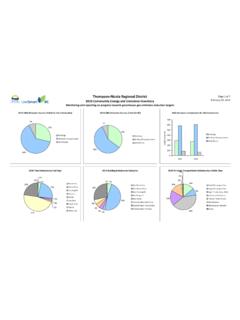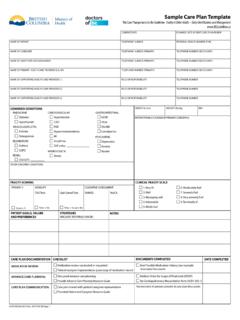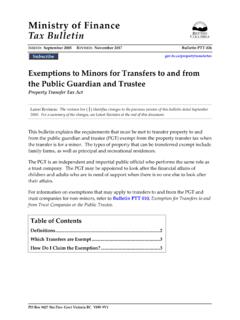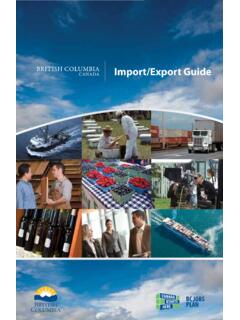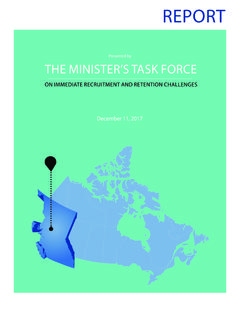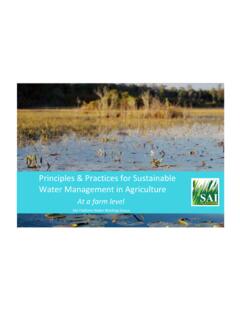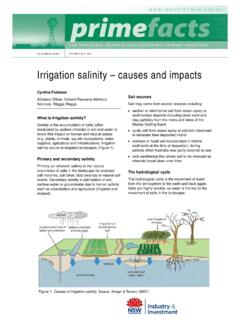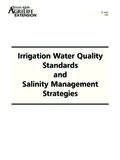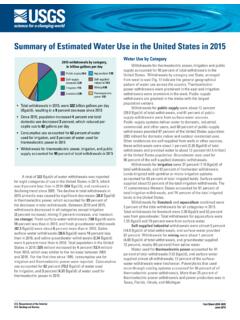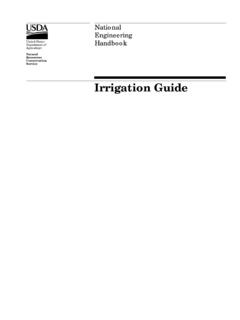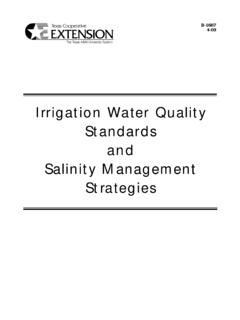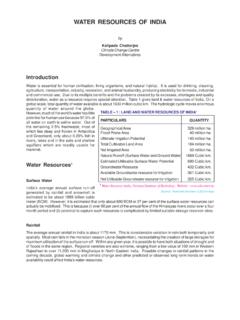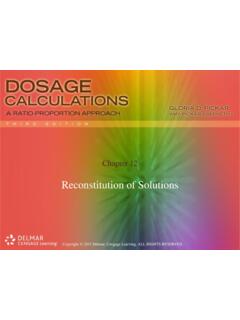Transcription of Best Practices for Prevention of Saltwater Intrusion
1 BEST Practices FOR Prevention OF Saltwater Intrusion [ 1 ]Best Practices for Prevention of Saltwater IntrusionWhat is Saltwater Intrusion and why is it a concern? Saltwater Intrusion occurs when saline (salty) water is drawn into a freshwater aquifer. Saltwater Intrusion can affect one well, or multiple wells in an aquifer, making the water unpotable (unpleasant to drink). People with hypertension should not drink groundwater with a high salt content. The health of plants and fertility of soil can be negatively impacted if irrigated with saline groundwater. Once Saltwater Intrusion occurs, the changes in the aquifer may be permanent or may take many years to causes Saltwater Intrusion ? Saltwater Intrusion can occur due to either natural processes or human activities. In aquifers adjacent to the coast and on islands like the Gulf Islands, freshwater floats as a lens above the Saltwater , forming a wedge that extends inland from the shoreline (see Fig. 1). Salinity typically increases gradually at the base of the freshwater lens, but in fractured rock aquifers a single fracture can deliver Saltwater to a well (Fig.)
2 3). The thickness and depth of the freshwater lens can vary seasonally, or over a longer term due to changes in the amount of precipitation and recharge occurring. Well pumping can also alter the location (depth or distance inland) of the Saltwater -freshwater transition zone (Fig. 2). While intermixing of freshwater and seawater is one of the main causes of Saltwater Intrusion in coastal , groundwater within deeper aquifers may also be salty due to geologic processes and interactions between rocks and water over a long time period ( millennia). If a well draws water from one of these deeper aquifers, it can cause saline water to migrate or mix with fresher groundwater in shallow aquifers. Isolated areas of Saltwater have also been found at relatively shallow depths < 50 m in some areas such as Saanich, Mayne Island, Saltspring Island and near areas are at highest risk?Areas at highest risk of Saltwater Intrusion include locations: Close to the coast; Where there is a low to moderate slope; On peninsulas or in areas with a limited source area for groundwater recharge; Where there is a high density of wells; Where there are high rates of pumping from a single well or from multiple wells in a coastal area; Where the static (non-pumping) groundwater level is at or below sea Practices FOR Prevention OF Saltwater Intrusion [ 2 ]What are the indicators of Saltwater Intrusion ?
3 Saltwater Intrusion is indicated by elevated concentrations of chloride and higher electrical conductivity of groundwater compared to average conditions in an area. These indicators of salinity are easy to measure, and may vary seasonally, for example, they are likely to be higher during the summer, or may increase over time, related to factors such as pumping. Wells containing groundwater with chloride concentration greater than 150 mg/L, specific conductivity greater than 1000 S/cm, or total dissolved solids (TDS) >700 mg/L are considered to be affected by Saltwater Intrusion (see reference 2). For coastal British Columbia these thresholds have been established as operational objectives, meaning, a well should only be pumped if it is capable of producing water of this quality or will taste noticeably salty when chloride concentration is 250 mg/L, the guideline for Canadian drinking water ZoneSaline GroundwaterFreshwaterWater TableWellLand SurfaceSeawaterTransition ZoneSaline GroundwaterFreshwaterWater TablePumpingWellLand SurfaceSeawaterTransition ZoneSaline GroundwaterFreshwaterWater TableWellLand SurfaceFractures withSaline WaterFigure 1: Under non-pumping conditions there is an equilibrium established between fresh and saline groundwater at 2: Pumping or other disturbances ( sea level rise, reduced recharge) can lead to upconing or inland movement of the freshwater- Saltwater interface.
4 If a single well is over-pumped or multiple wells are pumping, a large area of the aquifer may be impacted by 3: In a fractured bedrock aquifer a single fracture can deliver Saltwater to the coastal , wells containing groundwater with chloride concentration greater than 150 mg/L or specific conductivity greater than 1000 S/cm are considered affected by Saltwater management Practices in areas at high risk of Saltwater Intrusion :Well drilling:Well siting: Avoid drilling in locations immediately adjacent to the coast within 50 m. Well depth: Avoid drilling excessively deep within areas proximal to the coast. The depth to the freshwater- Saltwater interface varies locally, and drillers often have local knowledge, based on past experience, regarding the depth that they might expect to encounter salty water . There are established formulas for estimating the depth of the transition zone based on static groundwater level Ghyben-Herzberg, Hubbert (see references 3, 5), although these formulas may be inacurate for fractured alteration: Avoid using technologies such as hydrofracturing in areas <100 m from the coast to reduce risk of opening fractures that are directly connected with the sea.
5 Know the risks: Be aware of areas that are at risk of Saltwater Intrusion and educate property owners, site managers or water system operators that their well or locale could be affected. BEST Practices FOR Prevention OF Saltwater Intrusion [ 3 ]Monitor during drilling: When drilling in coastal areas, drillers should use a hand held meter to measure specific conductivity or salinity to monitor the quality of water encountered during drilling. If there is a significant increase in the measurements during drilling, consider stopping, and testing the chloride concentration of the groundwater. If a saline zone has been encountered it may be necessary to seal the well below a certain depth to prevent this water from entering shallow freshwater wells: Close unusable ( very low yielding) wells or wells that are no longer needed. Abandoned wells, open boreholes, wells with failing surface seals or corroded casings can provide a flow pathway for aquifer cross-contamination and the vertical movement of saline groundwater.
6 Refer to the water Sustainability Act (reference 6) for the rules regarding well closure. Get advice: If needed, consult a qualified professional ( hydrogeologist) for help assessing Saltwater Intrusion risk, interpreting water quality tests, or designing a monitoring program. Well pump set-up and well operation:Reduce use: Conserve water , install low water use appliances and irrigation systems, xeriscape gardens, and consider options for water depth: Reduce the pump , high-frequency pumping: Increase the frequency and reduce the duration of well pumping ( well sipping ) to minimize drawdown in the well and the surrounding timing: For multi-well systems, program the wells to pump at different times rather than storage: Increase water storage ( cisterns) and pump in wet season for use in drier periods, or augment the supplies using water from other sources such as rainwater collection. Ensure water in tanks or cisterns is kept free from contaminants by following health guidelines for water storage and disinfection.
7 Prevent leaks: Install water meters or other alarms/indicators so that leaks can be detected and fixed quickly. Many Intrusion problems start with over-pumping because of an unchecked use: If a well is severely impacted by Saltwater Intrusion , it may be necessary to discontinue using it for a period of time, and use alternate sources, to give the well time to recover, or the well may need to be decommissioned permanently. Refer to the water Sustainability Act (reference 6) for the regulations regarding well operation and Saltwater options: water quality testing should include chloride and electrical conductivity. Sample the groundwater annually, preferably during the dry season. Record and track the water quality changes over time. Electrical conductivity indicates the concentration of dissolved solids that are present as ions (charged molecules) in a polar solution like water . In a mix of seawater with freshwater for example, chloride is typically one of the predominant ions present, therefore electrical conductivity can be used as a relative measure of chloride concentration.
8 Specific conductivity is the equivalent electrical conductivity of the solution at 25 C. This is a preferred unit of measure because it allows results from different sites or sample events to be compared more easily. Specific conductivity is reported in units of microSiemens per centimeter ( S/cm) and TDS in mg/L. Hand-held meters: Specific conductivity can be measured manually using a hand-held meter to test the water pumped from a well. The meter must be calibrated before use, using a solution with a known electrical conductivity, following the manufacturer s instructions. C-T-D transducers: Specialized pressure transducers, which measure conductivity, temperature and depth (C-T-D), may be installed in an access tube in the meters: Specific conductivity can be monitored using an in-line conductivity meter installed in the discharge line, including features like an automated shut off if the electrical conductivity goes above a certain level 900 hand-held meter used to measure specific conductivity (shown above).
9 BEST Practices FOR Prevention OF Saltwater Intrusion [ 4 ]Groundwater level can be measured within the well, and the pump programmed to shut off automatically if the water goes below a certain depth. water metering helps well owners or operators understand how much water is being used, encourages conservation, and assists with detecting uncontrolled leaks so they can be fixed : March 2016 Photo Credits: S. Barroso, G. HendersonReferences and further information:1 Registry of qualified well drillers/pump installers, WELLS database and other groundwater resources: Chemical indicators of Saltwater Intrusion for the Gulf Islands, British Columbia. By J. Klassen, D. Allen and D. Kirste, Department of Earth Sciences, Simon Fraser University. 2014. Available from the Ministry of Environment Ecological Reports Catalogue: 3 Is Saltwater Intrusion affecting ground water on Lopez Island, Washington? USGS Fact Sheet 057-00. 2000. 4 Risk of Saltwater Intrusion in coastal bedrock aquifers: Gulf Islands, BC.
10 By J. Klassen and D. M. Allen. Department of Earth Sciences, Simon Fraser University. 2016. Available from: 5 Saltwater Intrusion process, investigation and management: Recent advances and future challenges. By Werner, M. Bakker, V. E. A. Post, A. Vandenbohede, C. Lu, B. Ataie-Ashtiani, Simmons, and D. A. Barry. In Advances in water Resources, 51: 3-26. water Sustainability Act and Groundwater Protection Regulation now in effect: Waterscape Gulf Islands. By R. J. W. Turner, R. G. Franklin, J. M. Journeay, and S. Denny. Geological Survey of Canada, 2004.
